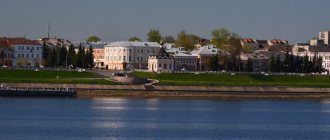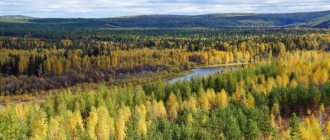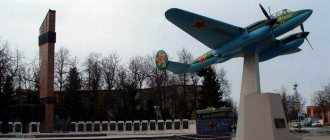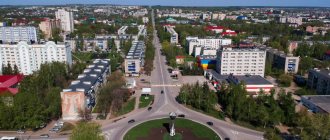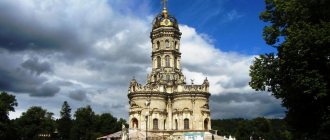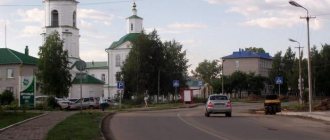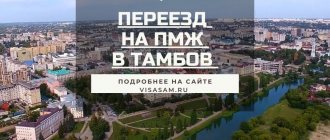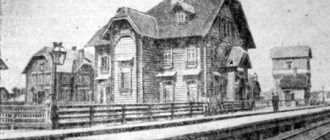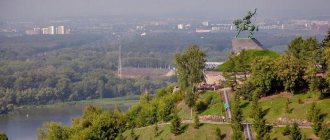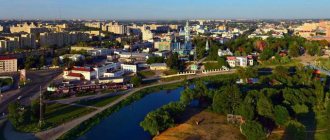Rybinsk is a beautiful ancient city on the Volga, with glorious traditions and rich history. Despite its huge industrial potential, Rybinsk has all the opportunities for tourism development. The city is located 84 km northwest of Yaroslavl along the P151 highway. In close proximity to the city there is the Rybinsk Reservoir, formed in the 1930s and it was the largest artificial reservoir in the world for its time.
Rybinsk history of the city.
Settlement on the territory of the city has been known since 1071. At first it was called Ust-Sheksna. In 1504 it was already mentioned as Rybnaya Sloboda in the spiritual charter of Ivan III; at that time and later it belonged directly to the Moscow kings and provided the royal court with fish. The settlement was made of wood, and no monuments from this era have survived in the city. In 1777, Rybnaya Sloboda, having become the center of the district of the Yaroslavl province, received the status of a city and the name Rybinsk. On August 3, 1777, Empress Catherine II granted the coat of arms and city status.
Where to stay overnight, cafes, restaurants
In the city you can spend the night in a hotel or inn for a reasonable price. Price from 1500 rubles per day. There are quite a lot of suitable options. This could be the city center or a residential area. There are many comfortable rooms in the historical area. There will be no difficulties with where to eat. Cozy cafes, restaurants, canteens are located everywhere. Mostly dishes of European and Russian cuisine are presented. The menu is rich in fish dishes for every taste.
Rybinsk history of the city.
After the transfer of the Russian capital, Rybinsk found itself in a very advantageous geographical position - at the crossroads of routes from St. Petersburg to the Caspian Sea and from Siberia (via the Kama) to the Baltic Sea, which was the main reason for the rapid growth of the city in the 18th-19th centuries. The deep-sea route from the lower reaches of the Volga ended here. Above the city, in the town of Perebory, the Volga became so shallow that people could ford it. Therefore, in Rybinsk there was a transshipment of goods and grain cargoes that came from the lower reaches of the Volga onto small ships that could move along the Mariinsky and Tikhvin water systems connecting the Volga with the Baltic.
City on the map
Where is the city of Rybinsk, in what region? If we look at the map of the Russian Federation, we will notice that geographically the city is located in the central part of our large country. The answer to the second part of the question is the Yaroslavl region. Here it is considered the second largest after the regional center.
If you are wondering where Rybinsk is located specifically, then we will give its coordinates on the map:
- 58.0499992 degrees north latitude;
- 38.8520012 degrees east longitude.
Rybinsk history of the city.
In 1863, a railway was built along Sheksna, and from 1870 along the Rybinsk-Bologoye railway, after which transshipment was carried out into trains. A large warehouse industry arose in the city, including one of the first oil warehouses of the Nobel brothers. The transshipment of cargo in the summer attracted a huge number of barge haulers and hookmen to the city, who lived right on the shore and many times outnumbered the number of permanent residents. Industry is also developing in the city.
How to get there?
regularly conducts trips to the cities of the Golden Ring of Russia.
Travel from Kazan
Travel from Cheboksary
Travel from Yoshkar-Ola
You can get to the village in a variety of ways. For those who need a quick way, air services are suitable. The trip will last only one hour. The plane departs from Moscow from Domodedovo Airport. Convenient to travel by train. The duration of your journey will be 8-9 hours. There is a direct train, so there is no need to change trains.
You can also use the train service. It departs from Yaroslavl. Travel time will last no more than 4 hours. In addition, scheduled buses and minibuses run to Rybinsk. The journey will take 7 hours.
Rybinsk history of the city.
In 1907, the Nobel brothers built a shipyard that still exists today in the suburban village of Slip. During the First World War, enterprises were evacuated to the city, giving rise to the currently operating factories. In 1916, the construction of an automobile plant began, on the basis of which an engine plant later grew. A new stage in the development of Rybinsk began with the industrialization of the country. Since the beginning of the 30s of the 20th century, the city has been growing rapidly, turning from commercial to industrial. The largest engine-building plant in the city was created at the base, producing mainly aircraft engines.
Best hotels in Rybinsk
Related materials:
- 37 must-see attractions in Paphos
- 28 best sights of Uglich, recommended for…
- 22 best attractions of Yaroslavl
- 29 best attractions in Orel, recommended for…
- 43 best attractions in Minsk, recommended for…
- 34 best sights of Vologda that are worth...
- 42 best must-see attractions in Rome
- 40 attractions in Limassol that are worth seeing
- 37 must-see attractions in Dubai
Did you like the article? Share with friends:
1
Rybinsk history of the city.
In 1936, as part of the “Big Volga” project, construction of the Rybinsk hydroelectric power station and hydroelectric complex began. The project had several goals: to provide a deep-sea route from the Volga to the Baltic and to the Moscow River, as well as to provide the growing industrial center with electricity. In Perebory, in the place where the Volga was especially shallow, a two-line lock and spillway dam of the Rybinsk reservoir was built. The Rybinsk Reservoir is unusually wide and shallow, it has flooded large areas of land in the floodplains of the Sheksna and Mologa rivers, for which the project has been criticized. In 1946, the city was renamed Shcherbakov, but already in 1957 its historical name Rybinsk was returned to it. However, in 1984 the city was renamed again - this time to Andropov, and in 1989 the name Rybinsk was returned again.
RYBINSK
RYBINSK, a city in Russia, in the Yaroslavl region, the center of the Rybinsk district. Us. 194.8 thousand people (2014); the second largest city in the region after Yaroslavl. Located on the river. Volga (port), at the entrance to the Rybinsk reservoir. Railway station. Road junction.
Arose in the 2nd half. 15th century like Rybnaya Sloboda, ch. The occupation of the inhabitants of which was to provide the grand ducal (from 1547 royal) court with fish. It was first mentioned in the spiritual charter of Vel. book Moscow Ivan III Vasilyevich (1503 or early 1504). From the 17th century also a large shopping center, approx. 1680 received posad rights. At 18 – beginning. 20th centuries one of the most means. transshipment centers for grain trade in Russia. The starting point of the Vyshnevolotsk water system. The city of Rybnoy (Rybnoslobodsk) since 1777, the name was fixed almost immediately. "R.". District town of Yaroslavl province. (1777–1921, 1923–29; in 1777–96 Yaroslavl governorship). In 1842, a grain exchange opened in the city. From ser. 19th century Large industrial enterprises began to be created in Russia and its suburbs. enterprises, among them - a rope factory (1859; one of the largest in Europe), mechanical. and shipbuilding. plant (1863; both enterprises belonged to N. M. and M. N. Zhuravlev), repair shop “Slip” of the Branobel T-va (1907); in 1916 a motor building was built. Russian Renault plant (now NPO Saturn). In 1870, railway traffic was opened. line Bologoe - Rybinsk (part of the Moscow-Vindavo-Rybinsk railway), in 1898 - Yaroslavl - Rybinsk. During World War I, a number of large industries were evacuated to the city. enterprises.
Sov. power was established on March 2, 1918. Center of the Rybinsk province (1921–23), district (1929–32, from 1935) and district (1929–30) center of the Ivanovo Industrial Region. (1929–36), from 1936 Yaroslavl region. In the 1930s R. included territories on the left bank of the Volga, where archaeologists studied Ust-Sheksna, the oldest settlement on the territory of R. (mid 11th – 16th centuries, first mentioned in the “Tale of Bygone Years” under 1071; numerous finds, including including fragments of Arabic coins from the 9th–10th centuries, metal and glass items, remains of ironworks from the 11th–13th centuries). In 1946–57 it was called Shcherbakov (in honor of A.S. Shcherbakov), in 1984–89 – Andropov (in honor of Yu.V. Andropov).
Photo by P. S. Pavlinov Rybinsk. Volga embankment. On the left is the Transfiguration Cathedral (1838–45). On the right is the new building of the Corn Exchange (1910–12).
The city center on the right bank of the Volga was built according to the regular plan of 1784 (architect I.M. Levenhagen); houses with classicist style have been preserved. facades (including those designed by K. I. Rossi, ca. 1810); 5-domed empire-style Spaso-Preobrazhensky Cathedral (1838–45, architects A.I. Melnikov, I.I. and L.I. Charlemagne, P.I. Visconti) with a high bell tower (1797–1804), St. Nicholas Chapel (1867 ) and the new building of the Grain Exchange in the neo-Russian style (1910–12, architect A.V. Ivanov). Also preserved: the church in honor of the Kazan Icon of the Mother of God (1697; paintings - 1767–68, F.I. Potatuev, M.A. Soplyakov, V.V. Kurenkov and others; narthex - 1824), 5-domed Assumption Church . (1740–52, built on in 1789; bell tower – 1807; iconostasis – 1825–27, master N. Antonov), cemetery churches of St. George (1790, rebuilt in 1877–1885) and Voznesenskaya (c. 1800–1808). Among the buildings 18 – beginning 20th centuries – Muchnoy (1796–1830, façade – 1878) and Krasny (1873–77, architect M. Lomakin) guest courtyards, the old building of the Bread Exchange (1806–11, architect G.V. Petrov), residential buildings and estates ( merchants Naumovs, 1830s); Sofia Women's Monastery (1860, closed in 1923, restored in 2009), Sretenskaya Church. (1867–73, architect M. A. Shchurupov), brewery "Bohemia" (1878, architect V. F. Hecker), Technical. school of M. E. Komarov (1896–97, architect A. N. Iossa), commercial. school (1902–05, architect A. A. Parland), railway station in Art Nouveau style (1904–05, architect S.I. Minash). Concert complex “Aviator” (1932–37, architect J. A. Kornfeld); monument to Gen.-L. F. M. Kharitonov (1949, sculptor M. G. Manizer) and others. On the left bank of the Volga - the ruins of the Mikhalkov estate Petrovskoe (house of the 1730s, etc.), a church in honor of the Iveron Icon of the Mother of God (1885–1890 , architect Ya. V. Zmiev).
State aviation technical University named after P. A. Solovyov (1955; current name and status since 2011), branches - Yaroslavl State. pedagogical University named after K. D. Ushinsky, Ross. People's Academy farms and government services under the President of Russia. Federation. State historical-architect. and artist museum-reserve [founded in 1927; formed by the merger of natural sciences. museum (1910) and art history. museum (1919); modern name and status since 1989] with branches: memorial House-Museum of Acad. A. A. Ukhtomsky (1990), Museum of the Mologsky Region named after. N. M. Alekseeva (1995, current name since 2009). Theatres: dramatic (1825), puppet theaters (1933).
Large industrial center of the Yaroslavl region Aviation production engines and parts for them, gas turbines (NPO Saturn, VolgAero), energy. and gas pumping units ("United Engine Corporation - Gas Turbines"), cable products, wires ("Rybinskkabel", "Rybinskelectrokabel"), radio-electronic equipment (instrument making plant), road rollers ("Raskat", road machine plant), snowmobile equipment ( "Russian mechanics"), printing. equipment, pipeline shut-off valves. Scientific research and development (KB "Luch", company "Turborus", research and production company "Start"). Shipbuilding and ship repair (factories: Vympel, Nobel Brothers Shipyard, hydromechanization). Enterprises of the food industry, metallurgy and metalworking, building materials, furniture, leather goods, etc. Rybinsk hydroelectric power station (composed of a capacity of over 350 MW; building 1937–52).
Near R. - the estate of N. I. Tishinin Tikhvino-Nikolskoye (main house, last third of the 18th century; Baroque church in honor of the Tikhvin Icon of the Mother of God, 1763–64), Pokrovskaya Ts. in the village Intercession (1791–94, iconostasis – 1795–98, carver N. Ivanov, icon painters A. Ivanov, I. Vasiliev).
Attractions. Spaso - Transfiguration Cathedral.
At the beginning of the 17th century. on the site of the current cathedral stood wooden churches, Preobrazhenskaya and Peter and Paul. The new cathedral was built in 1838-1851. at the expense of Rybinsk merchants. In 1846, the temple was painted by an artel of Palekh craftsmen. In addition to the wall paintings, the same team painted 40 icons for the iconostasis. The cathedral was consecrated on June 26, 1851. In 1891, a guardianship for the poor was founded at the cathedral, and a parochial school was founded in 1892. The cathedral was closed in 1929. In 1930, the drums of the domes were destroyed. In 1971 the chapters were restored. In 1996, the bell tower was transferred to the use of the Church, and in 1999, the temple was completely transferred to the use of the Russian Orthodox Church. The bell tower is about 116 meters high and is one of the tallest in Russia - the second tallest in Russia after the bell tower of the Peter and Paul Cathedral.
Old grain exchange.
One of the buildings that greets tourists on the banks of the Volga in Rybinsk is the old “pilot” exchange. Strict proportions make this building one of the best monuments of provincial classicism. Previously, merchants from all over Rybinsk traded bread here and made profitable deals. The author of the grain exchange is the architect Gerasim Varfolomeevich Petrov. The opening took place in 1811 - July 18. In 1830-1831, after the premises were renovated, the district and zemstvo courts moved into the stock exchange. In 1841, while passing through Rybinsk, Nicholas I gave the order to reopen the stock exchange and give it proper structure.
In 1860, M. N. Zhuravlev became the chairman of the exchange, after which the exchange began to be used for trading bread and in subsequent years became the largest in Russia. The building existed as a stock exchange until October 2, 1912. During Soviet times, the building was occupied by various educational institutions. In the post-war years, a river station and water police were located. Recently, the building of the old exchange has been on the balance sheet of the Rybinsk State Historical, Architectural and Art Museum-Reserve. Soon it is planned to open an exhibition on the history of Volga shipping and the Rybinsk pier.
Economy
Modern Rybinsk is represented by 43 large and medium-sized industrial enterprises. They form the basis of the city's economy, being producers of a wide variety of products.
A dozen Rybinsk enterprises representing the scientific and industrial complex are part of Rostec, accounting for almost 80% of the total number of domestic enterprises of this kind).
The leading role belongs to mechanical engineering, in more detail:
- engine building;
- shipbuilding;
- mechanical engineering;
- instrument making;
- production of electrical equipment and cables;
- road construction and special equipment;
- gas turbine units.
Continuing long-standing traditions, elevators continue to operate in Rybinsk. The construction sector is represented by 351 enterprises implementing new architectural projects.
The city's trade sector is represented by numerous department stores and convenience stores, fast food restaurants, three markets, and shopping centers. The tourism industry is actively developing.
The building of the new exchange.
The building of the new exchange was built in 1912 in the “neo-Russian” style, using stylized features of ancient Russian architecture, according to the design of the architect Alexander Vasilyevich Ivanov. The exchange building, together with the cathedral, built in the traditions of Russian classicism, and the bridge spanning the Volga form a single ensemble, which is the “calling card of the city.” Today the building houses the Rybinsk State Historical, Architectural and Art Museum-Reserve. In 1992, the city administration decided to transfer the building of the new grain exchange to the museum-reserve. The building was quickly converted into a museum, and on December 18, 1993, the grand opening of new exhibitions took place.
Famous people
Famous people of Rybinsk who glorified it in past times - representatives of the merchant class, industrialists and philanthropists Durdins , directors of Rybinsk enterprises - V.P. Balandin, A.A. Gerasimov , P.F. Derunov , military generals Kharitonov and Batov .
Among contemporaries, the personalities of Rybinsk residents are noteworthy - actor and director Evgeny Serov, and Stanislav Rostotsky , actors Mikhail Troynik and Anastasia Akatova, singers Alexa Aster, T1one and the Balagan Limited group. The founders of this musical group are friends from Rybinsk - folklorists, collectors of Yaroslavl ditties.
A unique personality of Rybinsk is the creator of the local museum “Rybinsk Fishes” Alexey Aleksashin. This researcher of the region's folk crafts knows the history of his family up to the fifth generation. He eagerly asked his parents about his ancestors, and now continues to explore his “roots” through studying the history of the region.
And he believes that knowledge of the traditions and customs of his people is the path to their development and prosperity. He constantly gives examples of residents of other countries who try to preserve family heirlooms and study their ancestry. He says that a person who knows his roots stands confidently on his feet.
Thanks to the interest of this person, the museum is replenished with new exhibitions telling about the history of the flooded Mologa and the original ornaments characteristic of the Yaroslavl region. His painted wooden fish are unique masterpieces worthy of extensive study.
Red Square.
A monument to Alexander II was erected on Red Square in 1914. The majestic monument was built with donations from townspeople and residents of the Rybinsk district, to commemorate the 50th anniversary of the liberation of peasants from serfdom. But the sculpture was destroyed in 1918; according to legend, the monument to Alexander was thrown into the Volga. In its place, a monument to V.I. Lenin was erected, which has a number of features that make it unique, namely, the leader of the proletariat is depicted in winter clothes and a hat with earflaps.
The city of Rybinsk has potential in the field of tourism. In Demino, a suburb of the city, a stage of the World Cup in cross-country skiing is taking place. The city hosts Merchant Day, the Festival of Poetry and Songs in memory of Lev Oshanin, numerous exhibitions and fairs. The city actively welcomes bus groups, cruise ships, and walking sightseeing tours are conducted around Rybinsk. Of great value and interest is the historical center of the city with buildings from the 18th - early 20th centuries.
